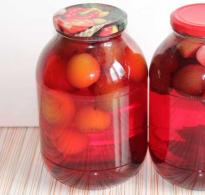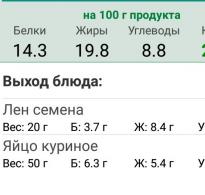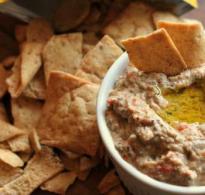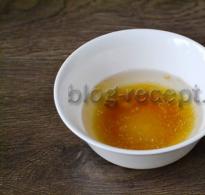Forb honey, how to identify real honey. Types and varieties of honey
With pain in my soul I have to admit that recently counterfeit, adulterated honey.
There are people who are ready to do any meanness for the sake of money. They use honey of unknown origin and questionable quality. After all, even with the help of bees you can make adulterated honey. For example, give it to bees and they will process it into honey
It will be delicious honey, but it will not have that vital energy that goes through the bee from the flower to the person. The only advantage of this honey is that it is easily absorbed by our gastrointestinal tract.
Let me give you another example: in hot water sugar dissolves, and for “smell” a little honey is added and sold. In one of the articles I read that some “craftsmen” add to sugar syrup a drop of rose oil, throw in pieces of honeycomb, dead bees, infuse, filter, package.
Moreover, these cunning people throw out such a surrogate at a time when it is already on sale. It is also liquid immediately after pumping, and a gullible buyer will not always immediately understand the deception.
If the honey is natural and mature, then by scooping it up with a spoon and swirling it, the honey will be wound onto the spoon with a ribbon in layers. And when it drips from a spoon like jelly, it’s a fake.
In winter, honey cannot be liquid. Liquid honey in winter is heated honey, and this is evidenced by the smell of candy or burnt sugar. This honey is clearly overheated and is dangerous to eat. After all, at temperatures of 45-50ºС and higher, carcinogenic substances appear in honey. And healing enzymes and vitamins disappear completely. Even drinking tea with high-quality natural honey is better as a “bite”, since in a hot drink the healing properties of this honey are lost.
With the help of simple tests you can determine whether you got a fake. Dissolve a spoonful of honey in a glass of water. The solution should be slightly cloudy, but without sediment. In the presence of impurities, a precipitate always forms.
Flour and starch are “calculated” by adding a drop of iodine to a small amount of honey diluted with water. If the solution turns blue, there is flour or starch in the honey. If instead of iodine you add a little bit of iodine to a solution of water and honey vinegar essence, and the solution hisses, which means there is chalk in the honey. Unnaturally light honey is produced when bees are fed sugar syrup or molasses. All these are 100% cases of honey falsification.
A few years ago, gypsies walked through our village. I was sitting on a bench near the house. Trade women came up to me and offered me honey in glass bottles at a reasonable price. three-liter jars. The price of honey is much lower than in our area. Honey is liquid. And imagine my surprise when I was offered to taste the quality of honey right through the edge of the jar. How can you be so careless about the priceless gift of nature!?
Man selling natural honey, knows its value and will let you try it with a small spoon, carefully, slowly. Moreover, those who sell “correct” honey never run around villages, there is no end to buyers, and they have no time to run. I don’t need to explain to you that the gypsy women’s honey was fake.
Let me give you another example. A beekeeper I know told me that in the summer beekeepers from afar come to their village to roam in KAMAZ trucks. Bees fly to flowers, carry nectar, and next to the hives whole bags of dry sugar are poured onto cellophane and there are drinking bowls with grape juice and water. These beekeepers do not have time to pump honey. But this is not natural honey, but fake honey, although it is no longer sugar syrup. This is an obvious pursuit of money, falsification.
I believe that the beekeeper and seller should have high responsibility for the quality of honey. Intermediaries are not interested in quality, the main thing for them is to buy more, pay less, and then sell fake honey more expensive and get a lot of income.
People won't pass by point of sale, which offers fresh, high-quality, very useful product. Fraudsters know this very well and therefore very often offer customers counterfeit goods.
This began a long time ago, since the sugar industry began to develop. The first honey fakes are regular sugar, mixed with water and some aromatic substances. Usually such fake honey is mixed with real honey to make it more difficult to detect.
Sometimes substances extremely harmful to human health were found in such impurities. Nowadays, technology has leapt forward.
Now molasses is used for counterfeits, invert sugar, sucrose, starch and various other fillers. Currently, counterfeits have reached such a level that they are difficult to detect even in laboratory conditions.
The state has taken upon itself to protect consumers from low-quality honey, but a lot of honey is bought from private individuals and therefore is not subject to any inspection. But impurities in honey, not to mention the fact that they reduce the benefits of this product, can cause direct harm to your health.
That is why you need to know that fakes are divided into:
1. Natural honey with added various additives, to increase mass, viscosity
2. Honey made from products of non-nectar origin
3. Artificial honey
The most common honey adulterator is sugar syrup. Unripe honey is often diluted with the same syrup to give it the missing sweetness.
First, the honey must be mature. After all, bees work on nectar for about a week: they evaporate the water, enrich it with enzymes, and break down complex sugars into simple ones. During this time, the honey is infused. Finished product bees seal it with wax caps - this is the kind of honey that has all its beneficial properties and can be stored for a long time.
Very often, beekeepers pump out honey during honey collection, without waiting for it to ripen, due to a lack of honeycombs. The water content in such honey is sometimes twice the norm, it is little enriched with enzymes and sucrose, and quickly sours.
To determine the maturity of honey, it is heated to 20 degrees, stirring with a spoon. Then the spoon is taken out and started to rotate. Ripe honey wraps around her. It may become sugary over time, this is normal. If you want to return it to its previous state, heat it slightly in a water bath. But sometimes this provokes further souring.
Using simple tests you can determine whether honey is adulterated. Flour and starch are determined by adding a drop of iodine to a small amount of honey diluted with water. If the solution turns blue, honey with flour or starch. If the solution hisses when adding vinegar essence, there is chalk in the honey. If in 5-10 percent aqueous solution honey when adding a small amount of lapis falls out white precipitate- sugar was added.
DETERMINING THE QUALITY OF HONEY
● By color
Each type of honey has its own color, unique to it. Flower honey is light yellow, linden honey is amber, ash honey is transparent, like water, buckwheat honey has different shades of brown. Pure honey without impurities is usually transparent, no matter what color it is.
Honey, which contains additives (sugar, starch, other impurities), is cloudy, and if you look closely, you can find sediment in it.
● By aroma
Real honey has a fragrant aroma. This smell is incomparable. Honey mixed with sugar has no aroma, and its taste is close to the taste of sweetened water.
● By viscosity
Take honey for testing by placing it in a container thin stick. If this is real honey, then it follows the stick as a long continuous thread, and when this thread is broken, it will completely descend, forming a tower, a pagoda on the surface of the honey, which will then slowly disperse.
Fake honey will behave like glue: it will flow abundantly and drip down from the stick, forming splashes.
● By consistency
In real honey it is thin and delicate. Honey is easily rubbed between your fingers and absorbed into the skin, which cannot be said about a fake. Adulterated honey has a rough texture; when rubbed, lumps remain on your fingers.
Before buying honey in reserve at the market, take the product you like from 2-3 regular sellers. To start, 100 grams each. Do the recommended quality tests at home and only then buy it for future use from the same sellers.
● Check if water and sugar have been added to honey
To do this, drop honey on a sheet of low-grade paper that absorbs moisture well. If it spreads across the paper, forming wet spots, or even seeps through it, it is fake honey.
● Determine if honey contains starch
To do this, put a little honey in a glass, pour boiling water, stir and cool. After this, add a few drops of iodine. If the composition turns blue, it means starch has been added. This is fake honey.
Honey is recognized by consumers and science as a useful, healing and most sought-after product from the entire beekeeping range, but only if it is natural. Lucky are those who know beekeepers and have the opportunity to buy proven products. What should an ordinary market buyer do, how to protect himself from counterfeits and be confident in its quality?
Honey varieties
Often sellers present a cheap product for which there is no demand as more popular and expensive. For this reason, you should have an idea of how to distinguish between different types of honey.
Color, aroma and taste qualities Each variety depends primarily on the plant, which is pollinated by bees immediately before production. But there is no pure honey, since insects have the habit of flying from place to place, often even changing the terrain. However, in each variety it is possible to determine which range of colors predominates.
Types and color of honey
Each type has its own external features and healing properties.
- Lime. Recognized as most useful in the fight against colds. Basically, it has a light amber color, but can be yellowish and transparent.
- Buckwheat. Is different rich taste With slight bitterness. The predominant color is dark brown or dark yellow with a reddish tint.
- Forest. The color range ranges from light yellow to light brown.
- Lugovoy. Has light shades.
- Acacia. The honey from this plant is almost transparent. The exception is the candied state, when the color becomes almost white.
- Clover. Amber color with shades from light to rich and a special aroma.
- Crimson. Only the honey took shades not from berries, but from flowers, so the product itself is light in color.
When buying honey, it is not possible to conduct any research, and the seller will not allow you to use additional substances to test your products, but you want to buy a natural and high-quality product. All that remains is to learn how to determine whether honey is really real by external signs.

- If there is foam with bubbles on the surface of the sweet product, this is a sign of fermentation, therefore, water has been added to it. The contents of natural honey contain wax, pollen and other inclusions of natural origin. Transparency and an overly clean appearance indicate that the product is artificial.
- When rubbed with your fingers, natural honey should be absorbed into the skin.
- When tasting, you should feel its tartness, slight burning, tingling in the mouth and moderate sweetness. When you feel the sweetness and taste of caramel, there is a possibility that the honey has been “heated”. This technique is sometimes used to add presentability to the product, but beneficial features in this case, they are lost, and in some cases (depending on the heating temperature) the product can even be harmful.
- Natural honey has a unique fragrant aroma, while its artificial counterpart is odorless.
- Don't be alarmed when a bee product becomes candied. This is an indicator of naturalness, since it is subject to crystallization, unlike a fake. Knowledgeable buyers do not always strive to purchase honey in liquid form, but its crystallization indicates excellent quality, which is the most reliable test.
Checking a bee product at home for additives
Viscosity maturity indicator. A product that has undergone a certain processing by bees, reached a minimum degree of humidity and is sealed by them is considered to be of high quality and mature. Some unscrupulous beekeepers, in pursuit of profit, begin pumping out honey before the process is completed and it reaches maturity. As a result, the product is not intended for long-term storage, fermentation begins in it, and taste and healing qualities are lost.

At home, checking for ripeness can be done using a regular spoon, with which you should scoop up a little honey and lift it until a wide, elastic stream forms. It should flow continuously and settle in a slide without spreading.
Again, use a spoon to scoop up the result of the bees’ work, lift it and scroll it, holding it horizontally, around the axis. The honey should not drip. This shows his maturity. Otherwise, it will look like a liquid mass and begin to spread over the surface.
The candied product began to divide into liquid and crystallized parts - an indicator of immaturity.
Weight check. Honey is heavier than water. Average weight 1 liter of honey is 1.4 kg excluding utensils. If this indicator is less, then a significant portion of water is present.
Simple ways to check the naturalness of honey
- Dissolve one teaspoon of honey in warm water and leave to stand for an hour. Falsified bee product will leave sediment at the bottom of the glass or flakes floating on the surface.
- Drop some honey on a piece of paper and set it on fire. Quality product will remain unchanged on burnt paper. The fake will turn brown like burnt sugar, and will leave a corresponding smell.
- An effective way to check the naturalness of honey and convenient even when purchased at the market is a chemical pencil. When it comes into contact with moisture, it changes color, so by dipping it into a bee product, you can easily determine whether the product they are selling you is real or diluted with water with the addition of granulated sugar.
Sugar is quite often a component of counterfeit products. Beekeepers recommend checking its presence at home in several ways.
- Dip a little honey into hot milk - if it is fake with added burnt sugar, it will curdle.
- Tea with natural honey will color it dark color, the fake will not change.
- Place a piece of bread crumb into the sweet and leave for 10-15 minutes. Hardened bread is a sign of quality; if it softens, then you have honey with the addition of sugar syrup. Questionable quality also reveals White color, close to sugar.
- Drop a little honey onto absorbent paper and try to smear it. If it works and there are wet marks left, you can rest assured that the surrogate contains water or syrup.
- A simple way to check at home for naturalness is the procedure with a hot stainless steel wire. Dip it in honey and take it out. The material at hand must be clean; if traces of the adhesive mass remain, it is not a clean product.
- Authenticity is easy to determine by heating the honey poured into a spoon over the fire. The counterfeit will ignite and natural product will char slightly.
Determination of other additives
Often, a damaged product needs to be sold by any means, and so that an uninformed buyer does not notice the signs Bad quality, sellers use various tricks. The quality suffers from the presence of additives not inherent in honey, but it becomes marketable.

One of the determinants is iodine. It is enough to put a few drops of it on sweet product, and you can determine the presence of starch added for thickness. As a result of the chemical reaction, the color will change to blue or blue. The more intense the color, the more foreign matter there is. In real honey, the shade does not change.
Added chalk is detected using vinegar essence. To do this, dilute a spoonful of the product in 0.5 cups of water and add vinegar. If the water hisses, it means there is chalk.
They also test for the presence of molasses. Mix 2 spoons of water and 1 spoon of honey and add a few drops ammonia, shake. A change in the color of the solution to brown and the formation of the same precipitate indicate that the additive is still present.
And it may also be useful as general information to know when honey is candied. The process generally begins one or two months after collection. An exception is mustard honey, which can thicken after 5 days if left in an open container. A white acacia product, on the contrary, remains in its original state for longer than six months, and if the jar is tightly closed, longer.
Unnatural honey may best case scenario, will not bring any benefit to your health, and at worst, have a detrimental effect on it. So you shouldn’t neglect checking, at least minimally.
Video: how to determine the quality of honey at home
Honey is a real treasure for the body. It contains useful minerals and vitamins that provide positive influence to your health. In addition, it is also very tasty treat. The scope of application is very diverse. It can be used for cooking cosmetics, as a food additive or for the treatment and prevention of various diseases. Every person needs to know how to determine the naturalness and quality of honey in order to avoid buying an artificial substitute for the product.
Honey: what is it like?
There are several main types of honey:
- May. This is the name given to the product obtained after the first pumping. It is worth noting that the name has nothing to do with the characteristics of the honey itself, but is of a purely philistine nature.
- Honeydew honey This is a product that is produced by bees from the sweet secretions of certain insects, and not from flowers. Honeydew honey of plant origin can also be obtained from the honeydew of trees such as maple, linden, spruce, fir, and hazel.
- Monofloral honey. This product received this name for the reason that bees collect it from the flowers of one type of plant.
- Polyfloral honey. A product that bees produce from nectar collected from several types of plants.
We have figured out the types of product, all that remains is to understand how to determine the quality of honey at home.
How to choose natural honey on the market?
Today in the market you can very often encounter the fact that sellers are trying to sell an unnatural product to the consumer. Such honey may have been pumped out earlier than expected, diluted with water or starch. Sometimes sellers even melt it specifically to make the product look more presentable. All these actions lead to honey losing its beneficial properties. And its heating leads to the formation of harmful substances in the composition. How to test honey? Is the product in front of you real or not? This actual question to date. Knowing just a few simple rules, you can easily distinguish an artificial product from a natural one.

What you need to know:
- To avoid purchasing melted honey, never look for it in late autumn or winter. liquid consistency. Even the most late varieties by this period they crystallize. If you go to the market in January and see a seller demonstrating that honey flows smoothly from a spoon, never buy such a product, because most likely it is melted. Unfortunately, sellers do this very often in order to make more profit.
- Have you noticed that honey is sometimes sold with foam on the surface? This doesn't mean it's fresh. Such a product was either pumped out ahead of time, or simply diluted with water, and this already significantly reduces the percentage useful substances in the composition.
- When purchasing honey in combs, you also need to be very careful. The main thing is to ensure that the cells are tightly sealed. Beekeepers do this in order to preserve the beneficial properties of the product.
How to determine the quality of honey by external signs?
Before you can determine the quality of honey at home, you first need to buy it. At the market it is not always possible to figure out whether the product in front of you is natural or not. But there are several signs, paying attention to which, you can buy good honey.
What to look for?
- Color. The first thing a person is interested in when looking at the counter is the color of honey. Of course, depending on the varieties, the shades may differ. However there is general rule. If the honey is fresh, there will be no sediment in it. If the product is cloudy, it means there are some impurities in the composition. If you notice several dark spots, it means the honey has been heated, perhaps more than once.
- The consistency of natural honey should be slightly viscous. If you twirl the jar in your hands and notice that the product is pouring too quickly, this means that it is either diluted or melted.
- Weight and taste. It is known that a jar with one liter of honey weighs approximately 1.5 kilograms. If you notice that it is much lighter, it means the product was diluted with water. Now as for the taste. Honey itself is sweet, but some sellers add additional sugar to it. Try the product on the tip of your tongue. If it's sweet, it means the seller sweetened it.
Testing honey at home by dissolving the product in water

If you are interested in how to determine the quality of honey at home, then one of the most effective ways it will dissolve in water.
Take a small mug of boiling water and add a little honey. Once it dissolves, the liquid will become slightly cloudy. It is important to know that there should be no residue left. If it appears, it means that the product contains impurities. If after adding honey the water remains clear, it means that sugar syrup has been added to it.
A sheet of paper is an easy way to check the quality of honey

In order to conduct this test, it is better to use low-grade paper rather than thick white paper. Even a thin napkin or regular toilet paper will do. Drop a small amount of honey on it and carefully observe how it behaves. If the honey begins to spread or seep through the napkin, it means the product is unnatural or diluted. Good product there will be one after which there will be no wet spots left on the napkin around the drop.
This method is great for determining the quality of honey at home. The test is carried out very quickly and gives you a clear answer whether the product you are looking at is natural or not.
Home quality test using vinegar
Every housewife has vinegar in her arsenal. Are you wondering how to determine the quality of honey at home using it? In fact, everything is very simple. Take some honey and dilute it with water, then add vinegar to it. Now let's see what happens next. If the consistency begins to bubble or foam forms, then this is a very bad sign, which clearly makes it clear that the composition contains chalk.
Iodine test
Now we check the quality of honey at home using iodine. This test will help to find out whether the product contains additional impurities, namely flour or starch.
Take a small amount of honey and dilute it in water. The water should not be hot, let it be boiled room temperature. Mix everything well so that the honey dissolves. Then add a few drops of iodine. If the solution turns blue, this means that the product contains flour or starch.
Wire method
You don't know how to test honey? Whether the product in front of you is real or not can be determined by ordinary copper wire. This test involves performing two simple steps:
- Heat the wire until it turns red.
- Place it in a container with honey and keep it there for literally 10-15 seconds.
After you remove the wire, see if it is still clean. If so, then this is a truly natural product. However, if a sticky mass remains on the surface, then the honey contains impurities or has been diluted with water.
Bread dough

Checking the quality of honey at home does not take much time, but you can be completely sure which product you are using: natural or not.
One of the most effective tests is to check quality using bread. Pour enough honey into the bowl to cover the piece. white bread, then lower the bread itself. You need to leave it there for about 10 minutes. If you see that the bread has softened or begun to spread, it means that the honey contains sugar syrup, and this already indicates that the product is unnatural. Real, pure honey Helps harden the bread.

Now you know how to test honey at home. All possible ways which give a clear result have been presented above. Never buy a large jar at the market at once, take a little to try first. Spend at home simple tests, and you will see what you purchased: a fake or a natural product. If it turns out that the honey is good, then you can buy it large quantity, but you will be sure of its authenticity.

Absolutely every person should know how to determine the quality of honey at home. Don't be fooled, always check the product for quality and presence of impurities. And the methods listed above will help you make the right choice.
Natural honey can only be liquid for a month after it was collected. Honey collection lasts from the end of July to the end of September. If in winter they offer you liquid honey, he is most likely unnatural. Qualitative real honey By this time it should thicken and begin to crystallize.
2. Check if the honey is foaming
If honey foams on the surface, it means that fermentation processes are occurring in it. It begins when the volume of water in honey exceeds 20%. This honey is definitely unnatural.
3. Smell the honey
Natural honey always has a characteristic smell. If the honey does not smell like anything, it was produced artificially.
4. Check if the honey is separating
Take a close look at the container with honey and check whether the mass is homogeneous. If the honey seems denser at the bottom of the jar and thinner at the top, it is fake. Most likely, the manufacturer added an impurity. Often, unscrupulous manufacturers put a mixture of semolina and molasses at the bottom of the jar.
5. Ignore the color
Color is not an indicator of the quality of honey; it can only indicate its variety. For example, buckwheat and cherry honey are usually dark brown, while acacia honey is light. Other types of honey can be dark amber, amber, light yellow, or even almost white.






